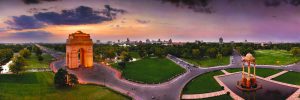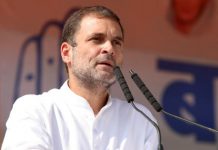 Amit Pasricha‘s photography masterpiece in 2007-‘Monumental India’ with text by Aman Nath and a foreword by William Dalrymple, caused a sensation when it was published. Your breath stopped as you gazed at the panoramic views of North India’s famed monuments and sites. But Pasricha had been captivated not just by the grand monument- the imposing Islamic tombs, the sprawling Hindu and Jain temple complexes, royal palaces, colonial grandeur and majestic forts, but also by the lesser known architectural gems. Not just the outer architecture but the inner halls, including the magnificent darbar halls where maharajas once held a formal audience, and the opulent interiors of their private apartments, with mirrored decorations, chandeliers, and luxurious brocades, all became the subject of his monumental panoramas. It was as if he changed the way we looked at scale and buildings. He went on to change his email to include the word ‘panoramist’ in his email id- so complete was his identification with this format.
Amit Pasricha‘s photography masterpiece in 2007-‘Monumental India’ with text by Aman Nath and a foreword by William Dalrymple, caused a sensation when it was published. Your breath stopped as you gazed at the panoramic views of North India’s famed monuments and sites. But Pasricha had been captivated not just by the grand monument- the imposing Islamic tombs, the sprawling Hindu and Jain temple complexes, royal palaces, colonial grandeur and majestic forts, but also by the lesser known architectural gems. Not just the outer architecture but the inner halls, including the magnificent darbar halls where maharajas once held a formal audience, and the opulent interiors of their private apartments, with mirrored decorations, chandeliers, and luxurious brocades, all became the subject of his monumental panoramas. It was as if he changed the way we looked at scale and buildings. He went on to change his email to include the word ‘panoramist’ in his email id- so complete was his identification with this format.
“Actually”, says Amit, a young and cool looking father of two, “‘Monumental India’ was not my first book using stitched panoramas. It was in Aman Nath’s ‘Dome over India’ that I first used this format”. On being asked how he moved to his signature panoramic format, Amit said with a laugh, “Well, first you need to be fed up with what you are doing. Then you have to be equally interested in both the scale and the detail in the world observed, and finally, you must want a svisual artist, to feel the need to convey the overall experience and not the fleeting moment, and become an experiential photographer”. It is evident that you need to be much more than that. You need to be expansive in the field of vision, as well as the imagination. As if to prove this assumption Pasricha adds “The shot has to be first composed in your head since your camera cannot do that. Your attempt is to bring your audience to where you stood as you conceived your photograph, so in viewing your picture they become partners in your production. While a regular photograph is composed by the eye through the viewfinder, the panorama can only be imagined since the human eye is totally incapable of comprehending on its own!”
“My panoramic photograph comes close to the visual impression you will carry back having spent a few minutes or hours around a certain place, influenced of course by my point of view. So, the cover of Monumental is the sum total of standing on the opposite bank of the Yamuna and experiencing a sunrise at the Taj. Incidentally, the iconic image of Vijaypath was the result of me spending several hours atop an extendable Fire ladder that I had borrowed from the Delhi Fire Services. So to those who say that one gets a good photograph through sheer luck, I would say ‘yes’, but more importantly, you need doggedness for sure!” No wonder they say about photographers that they make ordinary things look extraordinary since they do not look, but see!
You could well say that Amit Pasricha had this passion for photography in his genes. His grandfather, Fateh Chand Pasricha owned a photo studio on busy Janpath even before independence, which was well known for its portrait photography. His father is the famed and pioneering, award-winning photographer Avinash Pasricha, known for is defining dance and music images. Through his childhood he had seen his father, who was the photo editor of the magazine SPAN for 25 years, compose shots and work with cameras and lenses. A host of uncles and cousins are also well known photographers. In such a situation it is hard to resist that kind of osmotic learning, and despite a regular education from the premier college of Delhi University, St. Stephen’s College, Amit gravitated towards photography. Interestingly, while his father focuses on getting the moment right, Amit rejects the fleeting second and holds central in his composition the “sum of moments as captured in the overall impact. In effect what my photographs tend to do is to take away all distractions of heat and dust that comes with travel in India and allows you the essential experience”!
‘Monumental India’ came at the end of two and a half decades of shooting for the Ministry of Tourism and the Departments of Tourism of the many state governments. His pictures can be found worldwide inviting tourists to visit incredible India, and have been exhibited extensively in India, London and New York. In 2008 he won the India Tourism Award. Monumental India, which was co-published in many European capitals simultaneously, was acclaimed as one of the top ten coffee table books in the world and was a frequent choice of a gift for a visiting dignitary, including French president Nicolas Sarkozy.
After ‘Monumental India’, Amit produced two very special books- ‘The Sacred India Book’(2010) and ‘India at Home’ (2016). In both cases, despite the change is scale, and the fact that they are intimate looks at private practices, moments and spaces, he used the panoramic format. The text for both has been written by Amit’s wife- Bharati Motwani and both books are international bestsellers. “‘Sacred India’ is very special for me since as an Indian you are constantly engaged with the spiritual. I too found as I photographed for it that I had a special relationship with it”, admits Amit. The book won the prestigious German Photo Book Award formerly the Kodak Award.
Amit’s new project is an initiative he calls “India Lost and Found”. A line in the foreword that William Dalrymple wrote for him in ‘Monumental India’ alerted him to the fact that the several lacs of undocumented and unprotected monuments in India were in a fragile condition and vulnerable. Even local people were unaware of its value, often using it as a lavatory or a drug ‘adda’. He feared that they would be gone forever and so he began visual documentation in hope of the directory getting formed. “Many of these small monuments seem to have no name, or at least have lost them over time. How do you begin to describe the monument if you don’t know it exists”, says Amit with genuine concern.
But “India Lost and Found” is much more than that. “A monument is a living entity, almost an emotion and it makes you want to know about the people who constructed them and know about their culture and arts. In the west heritage is seen as a living tradition and so we learn about the Civil War battles or the food and clothing of the time through enactments. But in India our monuments are the preserve of architects and conservationists alone. We cannot link the tangible parts of culture with its intangible manifestations like food, music or clothes. We use our heritage at best as a set for films and serials. “India Lost and Found” is an attempt to enliven heritage monuments for the next generation through the inputs of experts and scholars. We use the digital space and social medialike Facebook and Instagram, as a ‘Crowd Collective’ project. Now over twohundredmonuments are posted on our social media platform awaiting comments and value addition by experts.
We have to first define this heritage for ourselves and then only can we leave it for our children and to use a modern term, we really need to re-brand our heritage,” says Amit who at present is investing personal time, labour and resources into this initiative. He hopes that before long he has the support of corporates and others in an exercise he believes all of India needs to do. Using modern technology, he will look towards delivering this knowledge through a youth friendly app for androidand IOS.He wants to involve the Liberal Arts colleges to drive the content and conduct phone photography workshops so that local communities become the gatekeepers of their own heritage. Like his panoramas, even this he is working in his head first!
letters@tehelka.com












